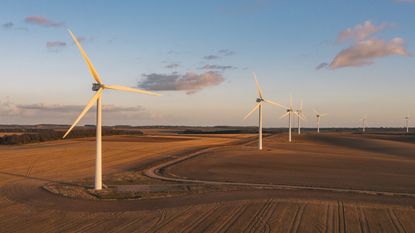7 infrastructure investment trusts for income and growth
These alternative investment trusts with international exposure could provide investors with an attractive income stream as well as capital growth, says Max King


Alternative income investment trusts offer attractive yields growing broadly in line with inflation, low or no sensitivity to the economic cycle and, thanks to share price weakness in 2022, often attractive discounts to net asset values (NAVs).
But many of them carry a risk which investors habitually ignore – their businesses are highly focused on the UK. Domestic revenues and earnings are vulnerable to weaker sterling, the long-term trend of which has been remorselessly downwards.
The misfortunes of social housing funds, such as Civitas and Home, serve as a reminder that much of the public and third sectors resent private sector involvement in their space, especially if it is for profit. Taxation can be changed on a whim, as it was for renewable energy, where “windfall taxes” have been levied to reduce the profitability caused by high prices, no matter how desirable extra investment is seen to be. Regulations and laws can be changed suddenly, based on little more than a storm on social media about supposed “rip-offs”, leaving investors stranded, as they have been in Ground Rents Income.
Subscribe to MoneyWeek
Subscribe to MoneyWeek today and get your first six magazine issues absolutely FREE

Sign up to Money Morning
Don't miss the latest investment and personal finances news, market analysis, plus money-saving tips with our free twice-daily newsletter
Don't miss the latest investment and personal finances news, market analysis, plus money-saving tips with our free twice-daily newsletter
Cautious investors will prefer to accept a slightly lower yield and slightly more expensive price for the added security of geographic diversification. The long-term record of these funds usually shows higher returns despite the initial handicap.
7 infrastructure investment trusts for income and growth
For example, BBGI Global Infrastructure has returned a compound 9.3% per annum since 2011 from a portfolio only 33% of which is based in the UK. The portfolio of 56 assets is “low risk, based on availability, not demand”, according to Duncan Ball, co-chief executive. 36% of the assets are based in Canada and the rest split between Australia, the US and Europe. 51% of assets are transport (roads and bridges), 21% is in healthcare and 9% in education.
As a self-managed fund, “we are incentivized by performance, not by asset growth” so annual costs are comfortably below 1% and total assets barely £1bn, far less than its long-established rivals. Yet, says Ball, “our pipeline is strong both from secondary investment opportunities and those direct from strategic arrangements with construction companies”.
The shares yield 5.1% and trade at a 3% premium to NAV, but that doesn’t make them less attractive than their ostensibly cheaper rivals.
3i Infrastructure, with over £3bn of assets, has an even better long-term record but takes more risk. It dubs its strategy as “core-plus”, meaning that it invests in assets with modest economic exposure, targeting an investment return of 8-10%. In fact, the compound annual return since the strategy was adopted in 2014 has been 18% and did not slow down in 2022.
Only 17% of the portfolio is in the UK, with 66% in Europe. The largest investments, 14% of the portfolio each, are TCR, which leases airport ground support equipment, and ESVAGT, which provides maintenance vessels for offshore wind farms. TCR clearly suffered from the reduction in flying during the pandemic, illustrating that 3iIN is not immune from external factors.
The shares trade at a 2% discount to NAV, having recently completed a small fund-raise, and yield “only” 3.5%, but the investment record is outstanding and likely to continue.
Pantheon Infrastructure (PINT) was listed in late 2021 so has not yet built an investment record. Consequently, its £475m of net assets was only 54% invested in nine businesses as of 31 December 2022, its shares trade at a 21% discount to a NAV which has yet to climb above the issue price and it paid a dividend of just 2p last year. Since the end of last year, further investments have been made and brokers Stifel estimate that net cash is now just 12% of net assets, of which half is committed. PINT has committed to paying 4p of dividends this year, raising the prospective yield to 5.1%.
In the 31 December 2022 update, the UK accounted for just 8% of the invested portfolio, of which digital infrastructure represented 41% and power and utilities 25%. With the support of Pantheon’s network, the portfolio approaching full investment and a good yield in prospect, the shares are, as Stifel argues, a “buy”.
In the renewable energy sector, there is a heavy focus on the UK but some potential bargains in overseas specialists. The shares of Ecofin US Renewables (RNEW, £109m of assets) and US Solar (USF, £267m) trade on discounts to NAV of 17% and yield around 7%, but the managers of the former resigned in the summer. A new team has now been appointed and the fund is said to be back on track, but it remains sub-scale and will need to trade at a premium to be able to grow by issuing shares.
Tiring of the discount, the USF board put the company up for sale in October, but the fund will be stranded if they fail to find a buyer. As for RNEW, returns have, so far, been disappointing and the asset value, translated into sterling, is vulnerable to the dollar weakening further.
The shares of Aquila Euro Renewables, with €450m of assets, trade on a puzzling 24% discount to NAV and yield nearly 6%, despite a total investment return of 13% last year. 56% of assets are in Spain and Portugal, 38% in Scandinavia and 6% in Greece, with a fairly even split between wind and solar. The recent results were highly reassuring about the outlook for future returns and the dividend.
The best geographic diversification in the sector is at the £250m Ecofin Global Infrastructure & Renewables Trust (EGL), of which I am a non-executive director (NED). The shares trade at around to NAV and yield 3.7%, but the compound net asset value return over five years has been 14.7%. 41% of the portfolio is in North America, 40% in Europe, 12% in the UK and 7% in other markets. The investments are all in quoted shares covering transportation and water utilities as well as energy. Much of the performance has been generated by the transition of traditional energy utilities to renewables.
Among the three battery storage companies, the best geographically diversified is Gore Street (GSF) of which I am also a NED. Christopher Brown of JP Morgan Cazenove estimates that, following recent acquisitions, 30% of capacity will be in the US in 18 months. There is also significant exposure to Ireland and a single project in Germany within net assets of £525m. The shares trade on a 16% discount to NAV and yield 7.3%.
Inevitably, the property real estate investment trusts (Reits) are heavily focused in the UK other than a few highly specialised funds. The exception is TR Property (TRY), with £1.35bn of assets of which 44% are in the UK and 56% in Europe. Over 90% of the portfolio is invested in listed equities, many of which trade at a significant discount to NAV.
The shares, along with the sector (which the portfolio has consistently outperformed), are at a low ebb, but there is growing evidence that pessimism regarding commercial property has been overdone. This makes the shares, trading at a 5% discount and yielding 5.4%, highly attractive to contrarian investors.
Just as those investing in equities for income should not confine their strategy to UK-focused funds, those investing in alternatives should have broader horizons. Patriotism may not, as Samuel Johnson said, “be the last refuge of a scoundrel” when it comes to investment, but it is very damaging to wealth accumulation.
Max has an Economics degree from the University of Cambridge and is a chartered accountant. He worked at Investec Asset Management for 12 years, managing multi-asset funds investing in internally and externally managed funds, including investment trusts. This included a fund of investment trusts which grew to £120m+.
Max has managed ten investment trusts (winning many awards) and sat on the boards of three trusts; two directorships are still active.
After 39 years in financial services – including 30 as a professional fund manager – Max took semi-retirement in 2017.
Max has been a MoneyWeek columnist since 2016 writing about investment funds in magazine and more generally on markets online, plus occasional opinion pieces. He also writes for the Investment Trust Handbook each year and has contributed to The Daily Telegraph and other publications.
See here for details of current investments held by Max.
-
-
 Most popular stocks of 2023: AI on the up while interest in Netflix plummets
Most popular stocks of 2023: AI on the up while interest in Netflix plummetsWe reveal the most popular shares of 2023 so far.
By Ruth Emery Published
-
 Marine North Berwick review: Scotland’s magical bird isles
Marine North Berwick review: Scotland’s magical bird islesMatthew Partridge combines a stay at Marine North Berwick with a visit to see the puffins
By Dr Matthew Partridge Published
-
 Investing in wine: how Cru Wine is reaching new audiences
Investing in wine: how Cru Wine is reaching new audiencesTips Gregory Swartberg, founder of fine wine specialist Cru Wine, talks to Chris Carter about how to start a wine collection
By Chris Carter Published
-
 Small companies with big potential
Small companies with big potentialMichael Taylor of Shifting Shares reviews his 2023 picks and highlights more promising minnows.
By Michael Taylor Published
-
 The MoneyWeek portfolio of investment trusts – July 2023 update
The MoneyWeek portfolio of investment trusts – July 2023 updateTips A decade ago we set up the MoneyWeek portfolio of investment trusts. They remain a compelling long-term bet says Rupert Hargreaves
By Rupert Hargreaves Published
-
 Women lead the way with ethical investments
Women lead the way with ethical investmentsDemand for more ethical investments has soared – and women are more likely to opt for them. Annabelle Williams, personal finance specialist at Nutmeg, takes a look at why.
By Annabelle Williams Published
-
 BoE: Mortgage payments to rise by £220 a month for households
BoE: Mortgage payments to rise by £220 a month for householdsMillions of households can expect a mortgage spike of around £200 a month - and some may even reach a extra £1,000 a month, the Bank of England warns
By Marc Shoffman Published
-
 What happened to Thames Water?
What happened to Thames Water?Thames Water, the UK’s biggest water company could go under due to mismanagement and debt. We look into how the company got itself into this position, and what investors should expect.
By Simon Wilson Last updated
-
 Where to invest in the metals that will engineer the energy transition
Where to invest in the metals that will engineer the energy transitionA professional investor tells us where he’d put his money. This week: John Ciampaglia, manager of the Sprott Energy Transition Materials UCITS ETF.
By Nicole García Mérida Published
-
 How investors can profit from high food prices
How investors can profit from high food pricesThe latest furore over grocery prices will die down, says David Stevenson. But the long-term outlook for soft commodities remains bullish. These are the stocks investors can buy to profit from high food prices.
By David J Stevenson Published









